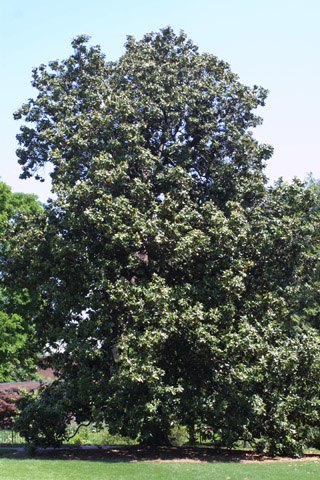
|

|

|

|

|

|

|

|
An individual instance of Magnolia grandiflora (southern magnolia)

Permanent unique identifier for this particular organism:
http://bioimages.vanderbilt.edu/vanderbilt/6-143
Notes:
This tree is the largest magnolia you see on the left as you face the central library from Library Lawn. There are many southern magnolias planted in this part of the main campus. This particular one is one of the older magnolias in the arboretum and is evident on aerial photos of the campus dating back many years. The history of this tree and its sister magnolia on the side of the lawn near Stevenson Center is closely tied to Wesley Hall, one of Vanderbilt's important early buildings that was destroyed by fire in 1932. To learn more about this tree and Wesley Hall, go to its history page.
Southern magnolias are unmistakable with their large creamy, white flowers and shiny evergreen leaves that are rusty underneath. Their twigs are encircled by the leaf scars and the fruits are typical for magnolias.
Southern magnolias are not native to Tennessee. They occur naturally further south. They are successfully planted in middle Tennessee, but they rarely reproduce successfully from seeds here. The large evergreen leaves also make the trees susceptible to severe damage from the ice storms that occur frequently here.
Southern magnolias are unmistakable with their large creamy, white flowers and shiny evergreen leaves that are rusty underneath. Their twigs are encircled by the leaf scars and the fruits are typical for magnolias.
Southern magnolias are not native to Tennessee. They occur naturally further south. They are successfully planted in middle Tennessee, but they rarely reproduce successfully from seeds here. The large evergreen leaves also make the trees susceptible to severe damage from the ice storms that occur frequently here.

|

|
|
Load database and switch to thumbnail view
Use this stable URL to link to this page:
http://bioimages.vanderbilt.edu/vanderbilt/6-143.htm
This organism is a living specimen that is part of the Vanderbilt University Arboretum with the local identifier 2-247.
This particular organism is believed to have managed means of establishment.
This organismal entity has the scope: multicellular organism.
Identifications:
Magnolia grandiflora
L.
sec. fna.org 1993
common name: southern magnolia
family: Magnoliaceae
Identified 2002-05-14 by Steven J. Baskauf
Location:
Vanderbilt University, Nashville, Davidson County, Tennessee, US
Click on these geocoordinates to load a map showing the location: 36.14592°, -86.80103°
Coordinate uncertainty about: 100 m.
Location of individual determined from GIS database.
Occurrences were recorded for this particular organism on the following dates:
2002-05-14
2014-03-13
The following images document this particular organism.
Click on a thumbnail to view the image and its metadata. Load database and enable navigation by taxon and organism.
| Image | View |

|
whole tree (or vine) - general |

|
whole tree (or vine) - general |

|
inflorescence - close-up of flower interior |